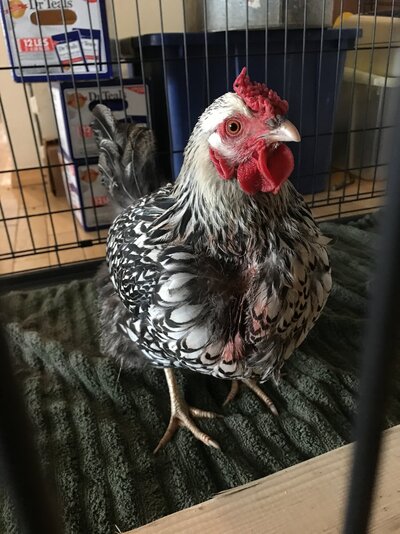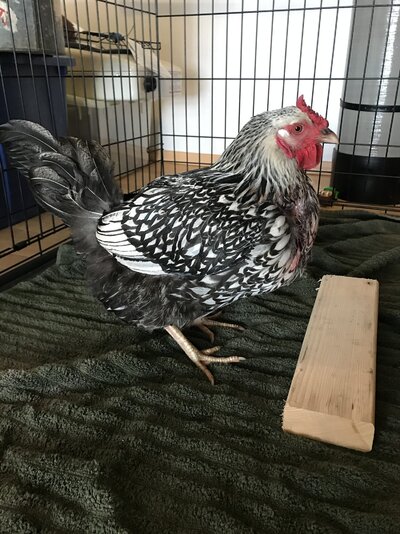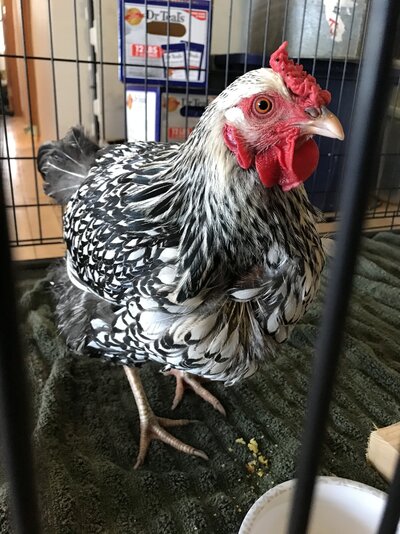Hey they’re BYC, this morning when I took my chickens up some fresh water I saw something a little concerning. My silver Wyandotte’s neck feathers were quite bloody, clearly picked at.
There are 3 specific chickens that have always had picked bald spots at the base of their tails, but it’s only about silver dollar sized... small enough that you can see it’s there, but it stays mostly covered be the other feathers. Obviously not ideal, but since there’s never been bloody or an escalation, I just wrote it off as standard family drama/pecking order stuff.
About a week ago, I noticed a small bald spot developing on my Wyandotte’s neck(one of the ones who is already picked on). It hasn’t really been growing, but overnight it got bigger and I noticed that there was quite a bit of dried blood on her feathers. Upon close inspection, I couldn’t see any broken skin. Just blood covering the shafts and feathers.
I have a flock of 9 hens. No rooster. They have about 80 sq feet in their coop, and about 400 in their run. Their little door leading to the run stays open, as the run is protected... so they have continued access to the whole space. And during the day, their run door is left open so that they can free range. I don’t think space is the issue, and I’m certain the picking is happening in the coop or on the roosts at night.
I’m planning on bringing her down to the house today to clean up the blood and dry her off, but I’m not sure what to do for her. She’s been doing fine in our cold weather, but with this bald spot bigger and our cold snap(low teens-single digits) set to last for a few more days, I don’t want her to suffer in the cold or continue to get picked bloody. I have pick-no-more that I can apply to her, but I’m wondering if it may get be better to keep her in the house in a crate for a few days? Or will that not make much of a difference?
There are 3 specific chickens that have always had picked bald spots at the base of their tails, but it’s only about silver dollar sized... small enough that you can see it’s there, but it stays mostly covered be the other feathers. Obviously not ideal, but since there’s never been bloody or an escalation, I just wrote it off as standard family drama/pecking order stuff.
About a week ago, I noticed a small bald spot developing on my Wyandotte’s neck(one of the ones who is already picked on). It hasn’t really been growing, but overnight it got bigger and I noticed that there was quite a bit of dried blood on her feathers. Upon close inspection, I couldn’t see any broken skin. Just blood covering the shafts and feathers.
I have a flock of 9 hens. No rooster. They have about 80 sq feet in their coop, and about 400 in their run. Their little door leading to the run stays open, as the run is protected... so they have continued access to the whole space. And during the day, their run door is left open so that they can free range. I don’t think space is the issue, and I’m certain the picking is happening in the coop or on the roosts at night.
I’m planning on bringing her down to the house today to clean up the blood and dry her off, but I’m not sure what to do for her. She’s been doing fine in our cold weather, but with this bald spot bigger and our cold snap(low teens-single digits) set to last for a few more days, I don’t want her to suffer in the cold or continue to get picked bloody. I have pick-no-more that I can apply to her, but I’m wondering if it may get be better to keep her in the house in a crate for a few days? Or will that not make much of a difference?



